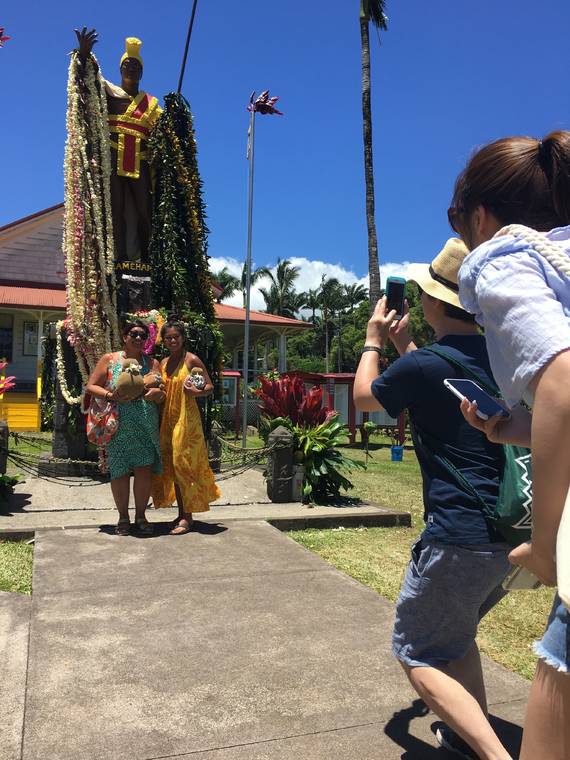KAPA’AU — Whether they came from around the world or around the block, the scores of people who lined each side of Akoni Pule Highway Tuesday morning all came here to celebrate the life and legacy of King Kamehameha I.
“Kamehameha was one ali’i — mo’i ali’i — that was not afraid to get down and dirty with the people,” said Lehua Kaulukukui as the fire engine leading the floral parade made its approach toward Kapa’au Tuesday as part of the North Kohala Kamehameha Day Celebration.
“And when I say down and dirty, he would actually work alongside the people in the taro patches and in building — rock wall or whatever it is — he would get right in there with the people,” she added. “And so that’s what I think, that is a model of leadership today.”
Just prior to being interviewed, Kaulukukui presented ho’okupu via an oli, “Ke Welina Mai Nei,” a chant of greeting that is “very, very old.” It talks of Kane, she said, and she thought it would be seasonal with the upcoming summer solstice.
From the hula ki’i performed in front of the statue and the procession of organizations such as the Royal Order of Kamehameha I and Ka’ahumanu Society prior to the lei ceremony and from the parade’s pa’u riders astride their horses to the Kohala High School Class of ’69 waving from the bed of a Ford F-140, the celebration showed a storied past and vibrant present alive in the region.
Even the lei ceremony, in which about 60 lei donated by families, businesses and organizations were placed on the statue prior to the first pa’u riders arriving into town, carried a nod to the past and present.
The more traditional lei were placed on the statue’s left arm, which held in hand an ihe — a spear — while more contemporary lei went on the statue’s right arm, which extended out toward the crowd.
Kumu hula Lorna Kapualiko Lim, who narrated the morning’s ceremony, said after the parade that the side with the ihe represents the ancestors, while the right side “is more welcoming.”
“That’s where you have the more modern-day flowers,” she said. “It brings and welcomes you, me and all of us.”
The lei, said Lim, will stay for two days before the families would return for them. Some families collect their lei, she said,and take it to their family’s burial places. Others, she said, take lei to Mo’okini Heiau.
Others who presented ho’okupu during the morning’s ceremony also spoke about Kamehameha’s significance.
“His values are Hawaiian values, and we should try our best to live those values every day,” said Jerry Kauahi of Halau Na Kipu’upu’u. Those values, he added, include taking care of each other and one’s family and perpetuating the culture.
“And never forget where we came from,” he added.
Others, such as Peta Brom of Cape Town, South Africa, weren’t as familiar with the life of King Kamehameha. Brom said taking the time to discover something about the cultures and histories of the areas she travels is something she really enjoys.
“You travel to a place not just to see the natural beauty but also to understand the people and, I guess, to reflect against your own values and perspectives of the world,” she said. “So a good way to do that is to balance against difference and then to also celebrate it.”
And for those who have grown up learning and hearing the stories about Kamehameha, Lim said she hoped Tuesday’s celebration, with its old chants and its chants about Kamehameha’s upbringing and those who raised him, offered a little more depth to the story.
And 200 years after Kamehameha’s death, it’s a story that keeps bringing people to North Kohala.
“I’ve been to Kamehameha Day in Honolulu; I’ve been to Kamehameha Day all over the place, but there’s something about here,” said Lim. “You can feel his spirit, and the families, seen and unseen, are still here.”








